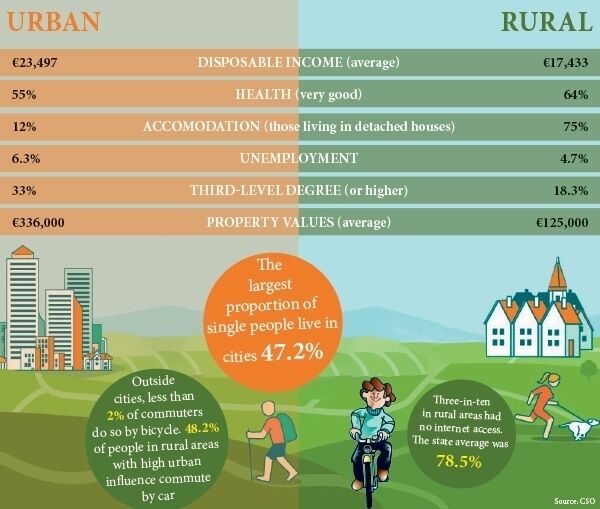CSO report highlights differences between urban and rural life in Ireland

City-dwellers are more likely to be single, have a higher disposable income and be located much closer to essential services, but they also face a higher rent burden and are less likely to commute by car.
In comparison, those in rural and remote areas are more likely to work from home, leave later for work and have a better quality of health.
A CSO report, , examines data from a broad range of sources to paint a picture of the differences in income, housing, health, education and commuting patterns, based on location. The report notes that just over 30% of people in Ireland live in rural areas — higher than the EU average of 27.3%.
It breaks the country into six categories: cities, satellite urban towns, independent urban towns, rural area with high urban influence, rural areas with moderate urban influence and highly rural/remote areas.
- There has been a fall in the number of people living in highly remote areas
- The median annual disposable income is €20,869. In cities, this increases to €23,497, and in independent urban towns, it is €17,433
- Unemployment rates are highest in independent urban towns at 6.3%
- Median property prices are highest in cities at €336,000 and lowest in rural areas at €125,000
- Almost 60% of people describe their health as 'very good'. In rural areas, this is higher, with 64% doing so in comparison to 55.2% in independent urban areas
Age, sex and geographical distribution
Between 2011 and 2016, Ireland's population increased by 3.6% to 4.69 million people. Of this, 2.9 million live in urban areas; while the proportion of those living in highly rural or remote areas declined by 0.6%.
In Cork, just 7% of people live in remote areas, much lower than the corresponding figure in Kerry, which was 27.5%.
Other counties had a much different make-up. In Kildare and Wicklow, for example, more than half the population live in satellite towns. In Louth, two-thirds live in independent urban towns.
Household and families
More single people live in cities than anywhere else. The rate of single people in cities was 47.2%, well above the State average of 41.1%.
In rural areas with high urban influence, 56% are married — 8% higher than than the State average; while remote areas have a higher percentage of widowed people at 7%.

The percentage of people living alone increased with age, too, and varied depending on location. The highest rates for people living alone were seen in independent urban towns, where 31.2% of those aged 65 and over and 50% of those aged 85 and over, lived alone.
The greatest proportion of young families are found in satellite towns.
Income
The average disposable income in the State is €20,869 but varies based on geography. People in cities have the highest at €23,497, with independent urban towns the lowest at €17,433.
The deprivation rate and deprivation rate for those at risk of poverty are highest for independent urban towns at 24.2% and 53.3% respectively.
Cities have the highest median household disposable income of the six classified areas in 2017 at €46,458. Self-employment is more prevalent in rural areas than urban areas.
Housing
More than three-in-four rural dwellers live in detached houses. Detached houses account for just 42% of the total housing stock. The smallest portion of detached houses is in cities, at just 12.3%. Nearly seven-out-of-ten city-dwellers live in cities.
Houses in rural areas are also more likely to be older. About 13% of rural homes were built before 1919. In contrast, 36.3% of satellite towns were built since 2001.
The number of new homes being built is on the rise in most areas but the strongest growth is, unsurprisingly, concentrated in urban areas. Some 3,948 new dwellings were built in satellite towns last year vs just 1,043 in rural areas.
Nearly four-in-ten new dwellings built last year were in Dublin.
Property prices and rent
Property prices are also dependent on location — the median price for residential property was €249,999 in 2018, with the highest prices in cities at €336,000, followed by €288,847 in satellite urban towns. The lowest median price was €125,000 in remote areas.
The rent burden - disposable income minus rent - is highest in cities, where the average rent is 31.0% of disposable household income. The average rent burden in Ireland in 2016 was 29.0%.
Proximity to services
In general, the more urbanised areas have shorter distances to everyday services.
For example, the average distance to a public bus stop in remote areas at 7.1km is 17 times longer than the average distance of 0.4km in cities. The average distance to a train station in rural and remote areas is 47.3km— 14 times longer than in cities at 3.3km.
The average distance to a HSE adult emergency department is 20.1km in Ireland, with the shortest average distance of 4.4km in cities and the longest of 45.0km in rural and remote areas.
Health and disability
More than half (59.4%) of people describe their general health as ‘very good’ while 1.6% say it s ‘bad’ or ‘very bad’. Rural areas with high urban influence have the highest rates with ‘very good’ health at 64.0% and the lowest rate of ‘bad’ or ‘very bad’ health at 1.2%.
The lowest rates with ‘very good’ health are in rural areas with high urban influence at 55.2% while these areas also have the highest proportion with ‘bad’ or ‘very bad’ health at 2.0%.
The proportion of the population with a disability is 13.6% in Ireland in 2016 but this varies from 15.4% in ‘Independent urban towns’ to 11.9% in ‘rural areas with high urban influence’.
Education
Just over one in three in cities have a third-level degree or higher in 2016.
Nearly three in 10 people (28.2%) who had ceased their full-time education in 2016 have a third level degree or higher. The highest proportion of people with at least a third-level degree is in cities at 35.3%, followed by satellite urban towns at 31.7%. The lowest proportion is 18.3% in highly rural/remote areas.
Commuting
Outside the cities, less than 2% of people travelling to work, school, or college do so by bicycle. Nearly 3 million workers and students commuted in 2016 — an increase of 9.3% on the 2011 figure of 2.7 million and a rise of 62% since 1986.
Driving a car is the most popular way to commute, with 40.6% of people doing so. The lowest proportion of commuters who drive is 33.6% in cities, with the highest at 48.2% in rural areas with high urban influence.
The highest proportion of commuters who cycle is 6.1% in cities, in contrast to between 0.5%-0.7% of commuters in the three rural areas.
Just under half the population travel less than 15 minutes to work, school or college in urban towns but, overall, the average commute is 24.3 minutes. Commuters in satellite towns are most likely to leave before 7am, with one-in-five leaving between 8.31am and 9am.
One-in-ten workers in rural/remote areas work from home, while just 2.3% of city-dwellers do so.













